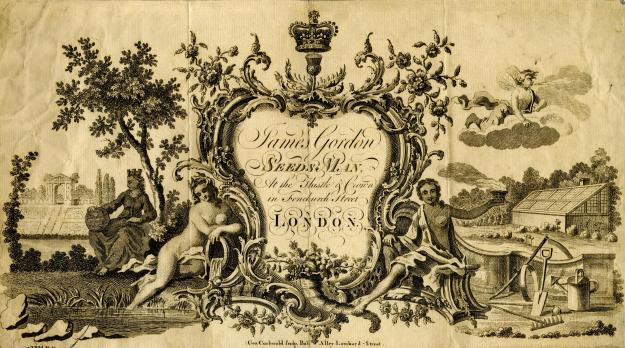
Trade card for James Gordon, seedsman c. 1770. Gordon was based at the Sign of the Thistle & Crown, near Philpot Lane, No.25, Fenchurch Street, London All images from the Sir Ambrose Heal collection at the British Museum © The Trustees of the British Museum
The contribution of individuals like James Maxfield, Samuel Smith and Arabella Morris to the horticultural landscape of 18th century England might have been entirely forgotten, but for the survival of their trade cards. Preserved over the years by collectors, these beautifully designed cards indicate each owner’s business at a particular moment in its history – their location, the services they provided, the goods they sold, and how they were positioned in the horticultural market of the day.
The British Museum houses a collection of over 9,000 trade cards amassed by Sir Ambrose Heal (1872-1959), chairman of Heal’s furniture shop on Tottenham Court Road, London. As well as being a successful businessman, Heal was an authority on London trades and shops, and his collection of trade cards, bills of sale, and other related ephemera was bequeathed to the British Museum in the 1960s.
This selection of highly decorative cards and bills of sale from businesses in and around the capital reveals a wide range of horticultural traders, from those providing landscaping services to those selling seeds and flower bulbs to ordinary Londoners. They include some of my favourites, including the traders mentioned above.
My thanks to the British Museum for making these trade cards available to everyone via their digital collections – links to the Sir Ambrose Heal collection below:
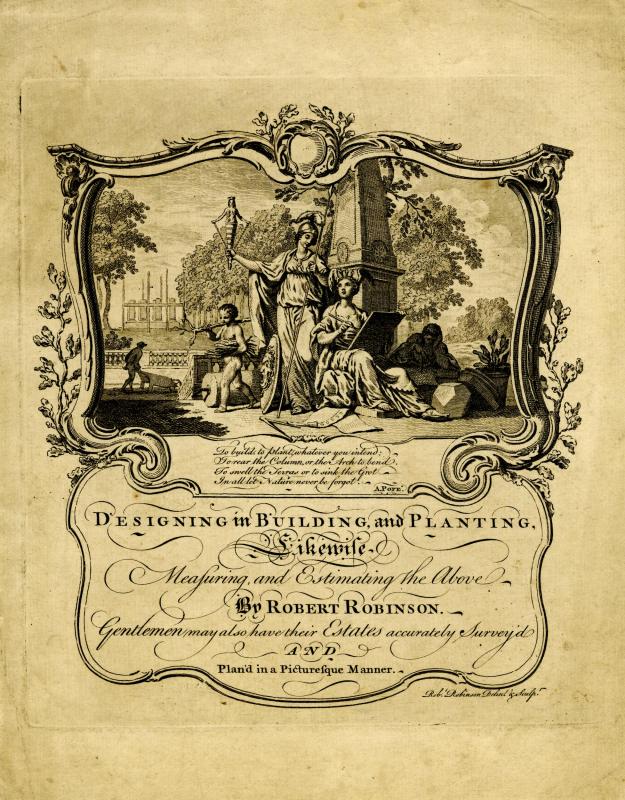
Trade card of Robert Robinson, land surveyor, landscape gardener, designer and architect c. 1760
Robert Robinson’s trade card outlines his skills, both in surveying estates, and laying them out in ‘a Picturesque Manner’. With its cartouche design and classical imagery, Robinson’s card is aimed to attract wealthy landowners, keen to develop their gardens in the fashionable landscape style. The British Museum records that Robert Robinson (1734 – 1794) was born in Durham and ‘employed in his youth by Lancelot ‘Capability’ Brown to execute many of his designs.’ Robinson ‘came perilously close to bankruptcy in 1780 and was forced to realise all his assets to meet the demands of his creditors. Although a relatively young man, he never seems to have worked again.’
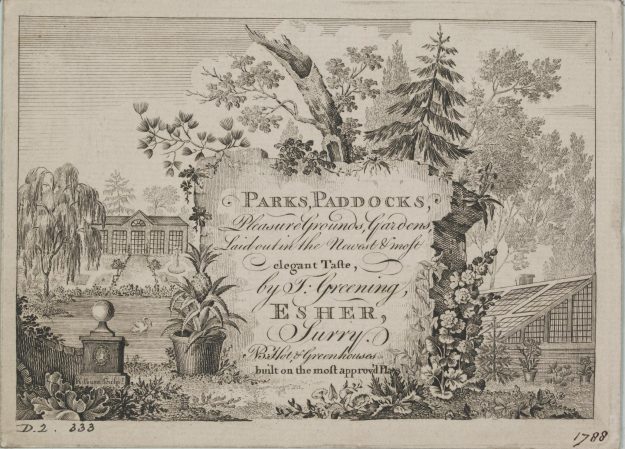
Trade card of Thomas Greening, gardener in Esher, Surrey; view of the garden of a house seen in the distance at left, a greenhouse to right, a lake and the end of a bridge to left, a lettered block of ruined stone at centre, overgrown with picturesque foliage, a flowerpot growing a pineapple in front. c.1777
Based in Esher, Surrey, Thomas Greening’s trade card advertises his skills in designing ‘parks, paddocks, pleasure grounds and gardens, laid out in the newest and most elegant taste.’ Behind the central cartouche, a greenhouse has been constructed against a wall and a pathway leads invitingly to an orangery, or perhaps a summerhouse? Amongst the choice plants is a pineapple, one of the most fashionable plants in the 18th century.
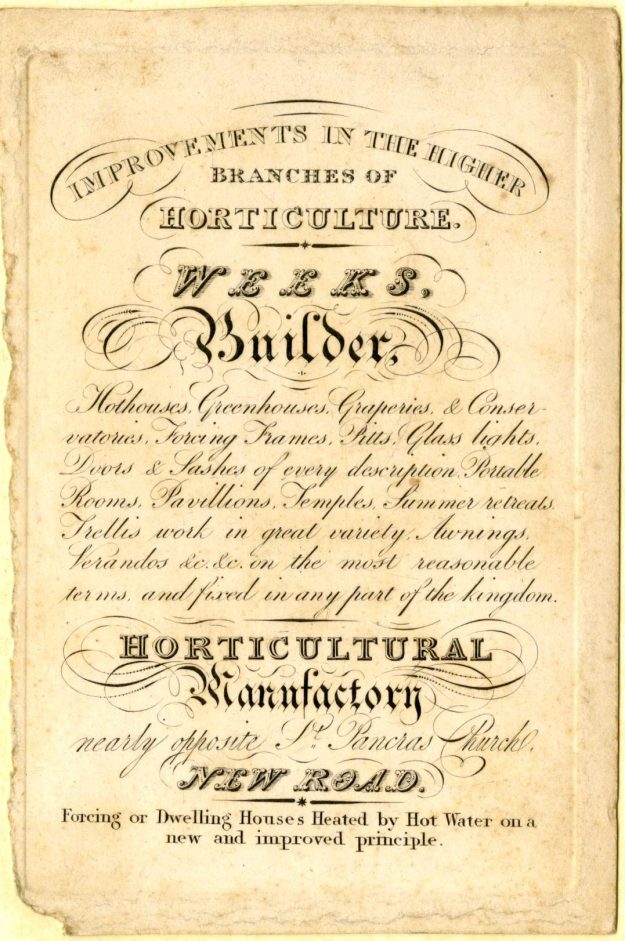
Trade card for Weeks, an expert in horticultural buildings from greenhouses to pavillions and temples c. 1790
Based close to St Pancras Church, Mr Weeks advertises his expertise in the construction of garden buildings and trellis work.
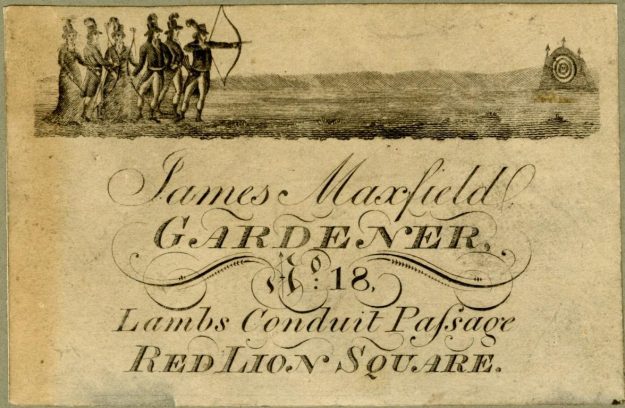
James Maxfield Gardener c. 1800
There’s something rather enigmatic about James Maxfield’s trade card. Describing himself simply as a gardener, Maxfield does not elaborate on the nature of the services he provided, but the image of the smartly dressed archers at the top of his card might suggest he was positioning himself towards the type of clients with the means to enjoy this pastime? His address is recorded very precisely as No.18, Lambs Conduit Passage, Red Lion Square, London.
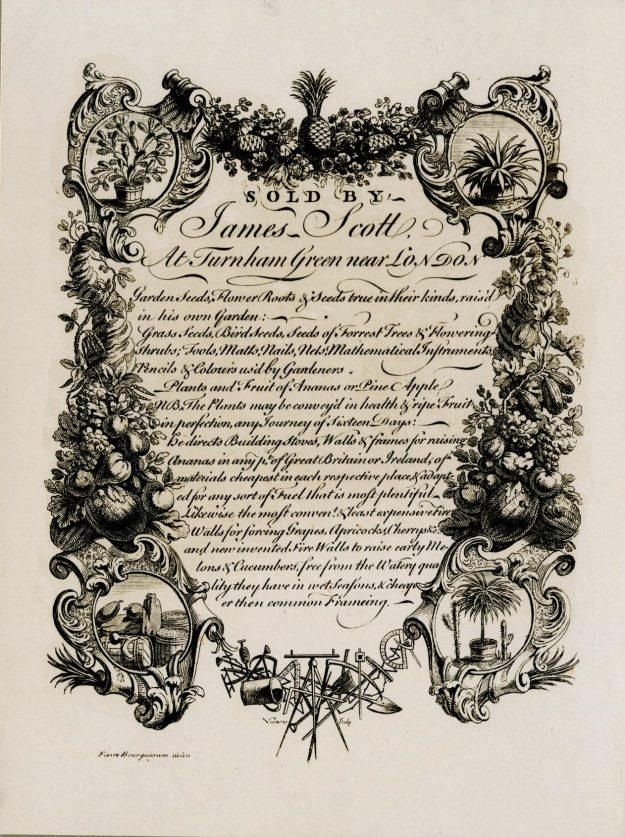
Trade card of James Scott, horticulturist. 1754
As well as supplying seeds and flower roots from this garden in Turnham Green, James Scott, appears to have been a specialist in the cultivation of the ‘plants and fruit of ananas or Pine Apple’. Scott also offers a service in the construction of ‘stoves, walls and frames’ to house these fashionable tender plants.
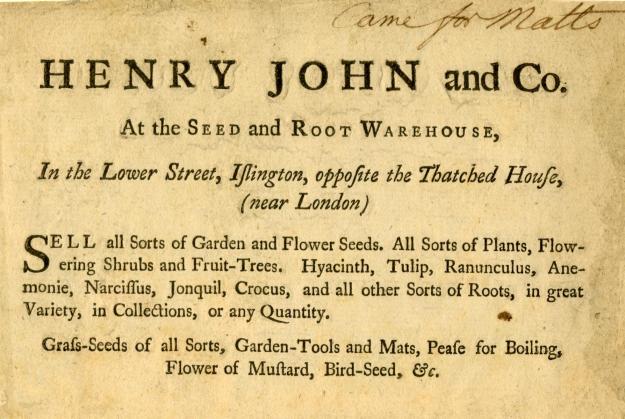
Henry John and Co Seed and Root Warehouse, Islington c. 1790
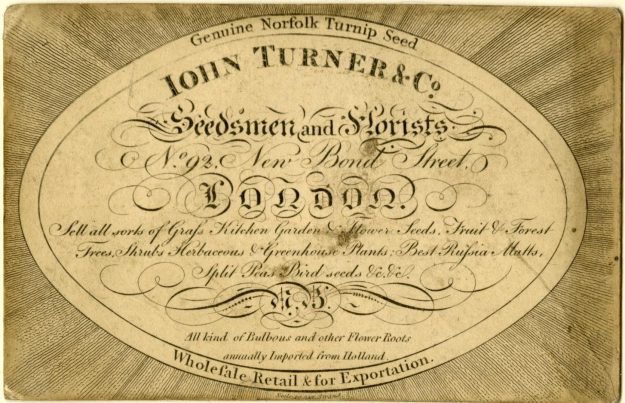
John Turner & Co, Seedsmen and Florists c. 1810
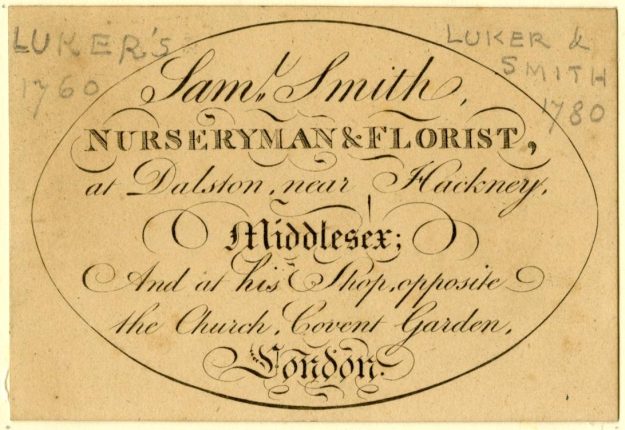
Sam Smith, Nurseryman & Florist at Dalston, near Hackney c. 1775
Nurseryman and florist Samuel Smith sold plants and bulbs both at his nursery in Dalston, Hackney and at his shop in Covent Garden. According to Sir Ambrose Heal’s research, Smith went into partnership with Warren Luker, another nurseryman, in 1760. A card (from the Lady Dorothea Banks Collection) also advertises Smith & Co’s shop in Covent Garden.
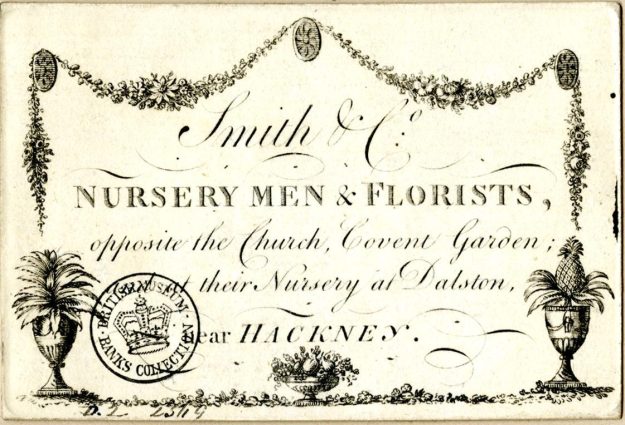
Trade card of Smith & Company, horticulturalists, c.1780 from the Lady Dorothea Banks Collection
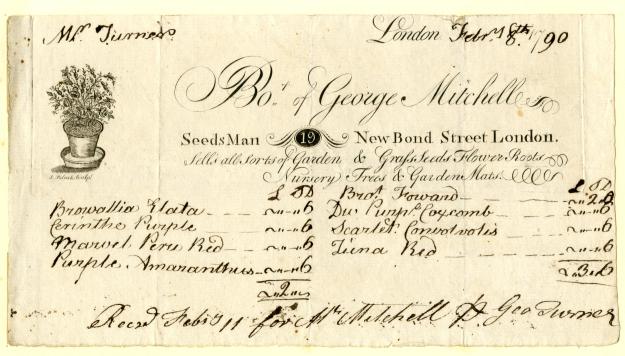
Bill-head of George Mitchell, horticulturist 1790
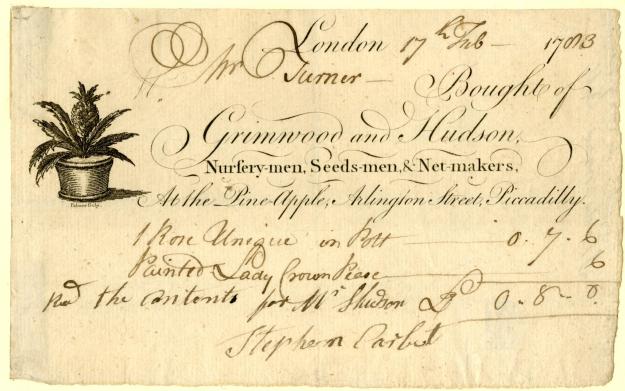
Grimwood and Hudson, Nursery-men, Seeds-men & Net-makers 1783
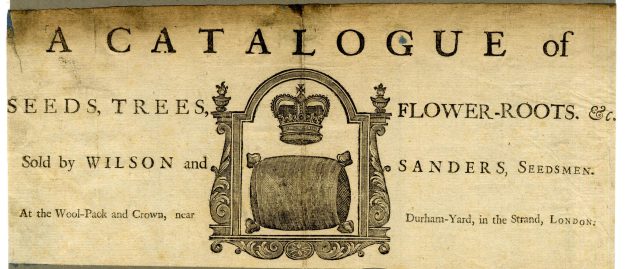
Wilson and Sanders, Seedsmen c. 1760

Arabella Morris, selleth all sorts of Garden Seeds, Flower Seeds and Flower Roots; 1748
I was delighted to find this trade card for Arabella Morris, a female horticulturalist trading in Covent Garden in the mid 18th century. Her card describes the goods she sold in great detail which included garden tools as well as seeds, bulbs, and plants. ‘Arabella Morris… Selleth all Sorts of Garden Seeds, Flower Seeds, and Flower Roots, Fruit Trees, Flowering Shrubs, Evergreens, and Forest Trees. Also Shears, Rakes, Reels, Hoes, Spades, Scythes, Budding and Pruning Knives, Watering Pots, Matts [sic], Sieves, and all Sorts of Materials proper for Gardening. Also Riga, Dantzick and Ditch Flax Seed, and all Sorts of Grass Seeds. N.B. The true Durham, and common Flower of Mustard Seed.’
In the biographical notes for Morris, the British Museum has included a note supplied by Amy Erickson (via email in 2022) who records that ‘Arabella Morris previously traded as Arabella Fuller at the same address, the widow then of Edward Fuller’.
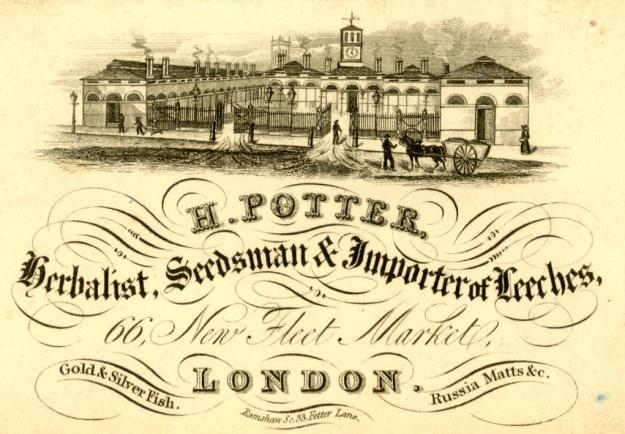
H Potter, herbalist, seedsman and importer of leeches c. 1800
These three cards demonstrate the crossover between herbal medicine and horticulture during this period, with traders selling seeds as well as remedies. H Potter’s company based at New Fleet Market describes the owner as a ‘herbalist, seedsman and importer of leeches’, while Thomas Bailey in Covent Garden sells ‘all sorts of physical herbs, roots and seeds’. His ‘scorbutic juices’ would have been a treatment for scurvy.
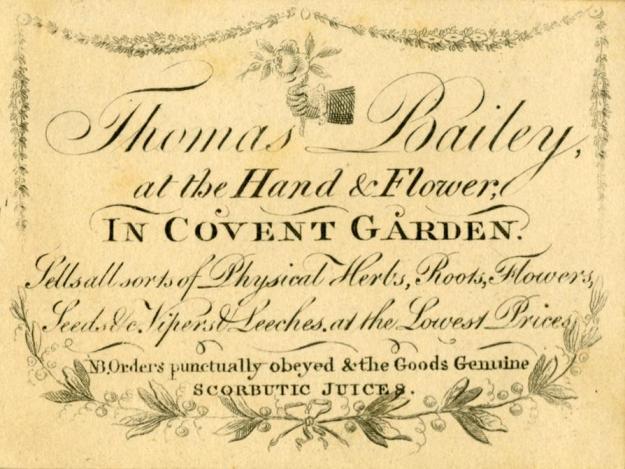
Thomas Bailey’s trade card shows the close association between horticulture and herbal medicine. c, 1780
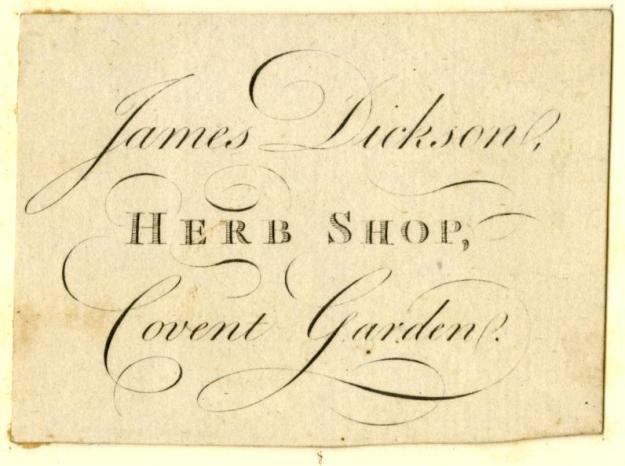
James Dickson, Herb Shop 1775
Further reading:
Sir Ambrose Heal’s Trade Card Collection at the British Museum here
